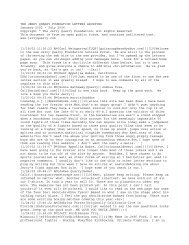January 2002 - October 2006 - The Jerry Quarry Foundation
January 2002 - October 2006 - The Jerry Quarry Foundation
January 2002 - October 2006 - The Jerry Quarry Foundation
You also want an ePaper? Increase the reach of your titles
YUMPU automatically turns print PDFs into web optimized ePapers that Google loves.
carried his arms low, never went to the body, and wandered around the ropes far<br />
too often in the second part of his career. He often was arrogant and didn't<br />
train properly, and seemed to want to make a fool out of an opponent ("See how<br />
great I am?), more than he wanted to win. Many of his blinding combinations were<br />
nice to look at, but in a lot of cases (proven via slo mo), many if not most<br />
missed, or were glancing blows. While they confused many opponents, the really<br />
smart ones launched an attack immediately after, when he often left himself<br />
split second vulnerable.However! He compensated with superb craftiness,<br />
extraordinary speed, was largely able to govern pace (except with Frazier), and<br />
was superb at tying his opponent up, eye thumbing, and opening cuts. Great jab<br />
(though I think Holmes's was better), could throw a decent uppercut when he<br />
wanted to, a super straight right and right cross, and even a hook, when he<br />
really set himself. Sadly, when his speed, reflexes and stamina were leaving<br />
him, he demonstrated his biggest gift of all, unequaled, I believe, by any other<br />
fighter ever - the ability to take a punch. When he commented that "Joe Frazier<br />
made me what I am today," he didn't know how right he was, though that wasn't<br />
what he meant.|<br />
|8/24/03 08:24:48 PM|Tubby Breslin|Fullerton, CA||bearstubastanchu||||10|Good<br />
observations, Roadscholarette. <strong>The</strong>se are examples of how Ali never learned how<br />
to box, by doing so many things wrong, beginning with leaning away from punches.<br />
He invented his own style and made it fantastically successful. Another great<br />
strength of his was his twisting or torquing punches that cut opponents. He also<br />
capitalized on pulling down the necks and shoulders of opponents in clinches,<br />
even the briefest clinches, for a cumulative effect of exhaustion on them. Some<br />
people tend to think of Ali as smaller than he was, 6'4" and 220 or more. Boxers<br />
and former boxers know that even glancing punches can hurt a lot, because of the<br />
mental scoring that goes aloong and the embarrassment of being hit. Ali kept his<br />
hitting your face and it humiliated and discouraged opponents, even making them<br />
mad and distracted from their business of fighting. besides, when it comes to<br />
knockout damage, it's not the power itself of a punch, but the snapping on a<br />
precise target to cause unconsciousness. (Sean O'Grady explains this well.)<br />
Clubbing a man into submission is a much longer and more difficult process than<br />
snapping him on the button or along the jaw. Anyway, Ali's greatest strength of<br />
all, and something he practically invented or rather reinvented for the<br />
contemporary age of boxing, was the psychological game. Many of us feel this<br />
part of the game, at least among two more or less equal opponents, is 90% of the<br />
whole contest. At least from the moment an opponent signed a contract to fight<br />
Ali, this hapless person was subject to trash-talking, shaming (even on Uncle<br />
Tom grounds, like Patterson and Frazier), and even weird behavior and threats<br />
(which rattled even Sonny Liston). By the time the opponent enters the ring to<br />
fight, he's likely to be a nervous wreck and intimidated. Against Ali, no one<br />
fought a man but rather a legend and an international symbol. Intimidation,<br />
verbal or otherwise, is as old as sports, but Ali magnified it almost to a<br />
cosmic level, bringing in archetypes of race, manhood, destiny, the underdog,<br />
and various elements of culture. This in part is why I call him a thinking<br />
fighter. <strong>Jerry</strong> <strong>Quarry</strong>, like most ranked fighters of that day, had some of<br />
his own mystique going for him. He was the rough, tough Irish brawler with<br />
killer instinct and a mean streak in the ring, the kind of guy who won't stop<br />
coming even when you break a 2x4 over his head. No one stepped in against <strong>Jerry</strong><br />
without fear. <strong>Jerry</strong> delivered, too, even in the bouts he lost. He is one fighter<br />
who never had anything to be ashamed of, and that was part of his huge<br />
popularity. <strong>The</strong>re was indeed no dog in any of the <strong>Quarry</strong>s. This gamesmanship<br />
and trash-talking and psyching out have grown way out of proportion now, so that<br />
a lot of boxing promotion is close to WW Wrestling. We see kids with only 5<br />
fights threatening to kill champions, and we see whole fights based on BS like<br />
"Redemption" in the upcoming Mosely-De La Hoya fight -- excessive machismo, and<br />
laughable. Ali made his head-gaming absolutely convincing, and often funny as




